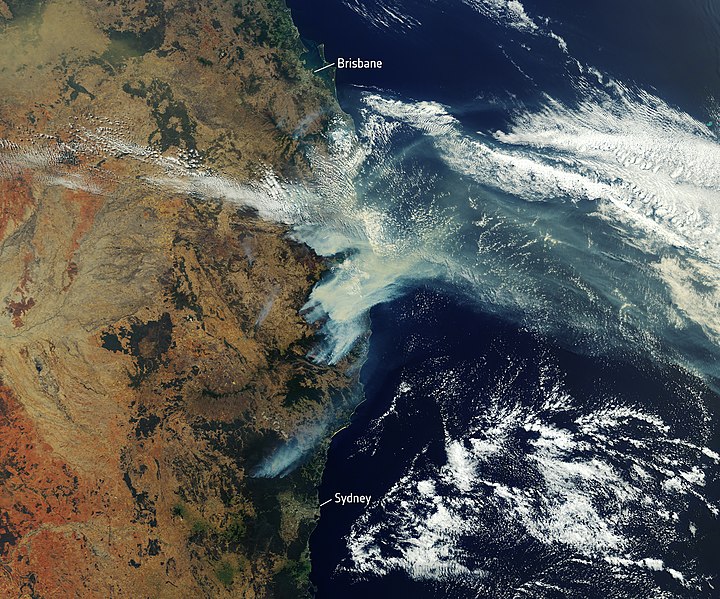Here’s What You Need to Know About Australia’s Wildfires
European Space Agency via Wikimedia Commons
January 27, 2020
On November 11, 2019, Australia began experiencing ravaging wildfires that have spread across the country. These wildfires have caused massive damage to the wildlife preserved in Australia; citizens consider the continent uninhabitable from the deadly smoke that has entered the atmosphere and making a trip across the globe. As of January 22, 2020, a total of 28 human casualties have occurred.
CNN stated from the country’s Bureau of Meteorology that Australia has been it’s driest over the course of decades. In December of 2019, a heatwave broke the record of the highest average temperature nationwide. Some areas of Australia have been engulfed in heat levels of about 40 degrees Celsius, or 113-120 degrees Fahrenheit.
Some of the wildfires have been triggered due to the worsening climate change over the decades. Each year, Australia experiences dry & hot summers that cannot be avoided. This heat causes natural disasters such as lightning strikes and droughts to occur more frequently. Dry lightning was the cause of wildfires in East Gippsland, Victoria. In just five hours, these fires have traveled more than twelve miles. According to CNN, humans can also be blamed. NSW police reported 24 incidents of people intentionally starting bushfires. As of November, officials have taken legal actions against about 180 people with charges against fire-related offenses.
As of Australia’s wildlife, about half of a billion animals have been injured, killed, and forced to flee their homes. An estimate of one billion animals has been affected nationwide, according to ecologists from the University of Sydney. According to the Federal Environment Minister Sussan Ley, about a third of koalas have been killed. Due to the fires, a third of their habitats have been burned down.
For months, states and federal authorities have been combating these disasters. According to CNN, there are more than 2,000 firefighters fighting these unyielding flames alone, and even more are being sent from the United States, New Zealand, and Canada. The federal government sent the military as a rescue campaign to save the civilians & animals that reside in the injured states, and also as a clean-up campaign to rebuild. This season of natural disasters is far from over. Australia is only half-way through its summer cycle, so the fires will most likely continue to spread and be confronted.
On January 18, 2020, thunderstorms and all-powerful rainstorms started brewing in Australia due to the leftover chemicals from the smoke entering the atmosphere. These storms have stopped some of the fires from spreading further; however, there are worries of floods being the next major problem to occur. These storms have hit Queensland, Victoria, and New South Wales. There have been no further updates that have been made of the evacuation of citizens & wildlife.
As high school students, we as a general group do not pay attention to nationwide problems enough. Tragic events like these occur without us being notified, or caring less of how serious the situation is. Unfortunately, we’re in a period of time when things can happen at any time, regardless of how they affect us currently. These international issues could injure our success in the future as the next generation. It may seem pointless to care about these events, but all of us are preparing to enter the age of adulthood, if some of us aren’t already. We must consider the things that go on and prepare to use our voices when they are accepted at the required age.



Nevaeh Cohen • Feb 6, 2020 at 1:09 pm
I think that this was a great article. It was very interesting and was worth reading. I learned many things that I didn’t know due to reading this article. It had very important details and I think the students for writing this article. I learned a lot.
Tanasia Ebo • Jan 27, 2020 at 10:47 am
Australia has had many wildfires which caused the continent to become uninhabited because of the deadly smoke. There are more than 2,000 firefighters. The heat in Australia causes it to happen more often.